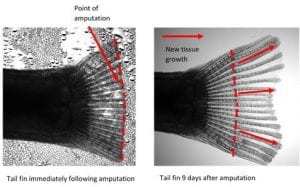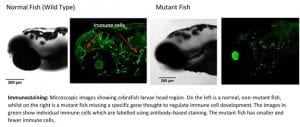The use of zebrafish in research by MSc student Alistair Vorster
The zebrafish (Danio rerio) is becoming an increasingly valuable organism for scientists studying the human genome and various disorders. This little freshwater fish may represent one of the most important tools for future research into developmental biology, and has already helped reveal a number of key genes associated with various human disorders, including those affecting blood cells, the heart and kidneys (e.g. bradycardia and congenital anaemia) (1).
Zebrafish are a tropical fish found in South East Asia, and their use in research began in the 1960’s (2). They have several characteristics which make them ideal for scientific research, including rapid reproduction and the ability to produce large numbers of transparent larvae which develop in eggs fertilised outside the womb, allowing any changes to be observed easily during early stages of development. They are also easy to look after, requiring less space than rodents and exhibiting quicker development than their mammalian counterparts. Their entire genome has been sequenced, with the latest update released in 2017 (3), which is of great use for genetic research through comparison with the human genome. 70% of human genes have a zebrafish counterpart, with 84% of human disease associated genes displaying a zebrafish ‘sibling’ (4). Genetic pathways and genes for development are often very similar between humans and zebrafish, such as for the heart, therefore they are an excellent model for vertebrate genetics and development.
Superhero powers?
One characteristic of zebrafish which makes them particularly interesting is their ability to regrow damaged tissue, including heart muscle, fin tissue and even neurons (5). This phenomenon, reminiscent of lizards that escape predators by losing their tail which then miraculously regrows, is leading scientists to investigate the methods of regeneration used by the zebrafish. It is hoped that by revealing the biological secrets behind this process we may be able to manipulate human cellular mechanisms to repair damaged tissue in the future, e.g. for sufferers of heart disease.
Research has shown that a special group of cells, called the blastema, is important for this regeneration. These cells form a bundle at the point of injury and show characteristics similar to stem cells, meaning that they can create the different types of tissue needed for regrowth (6). Interestingly, mature bone cells have also been found to revert back into more immature ‘stem’ like cells after injury and during regrowth, meaning that they can help to make new bone e.g. during fin regrowth (7).
Research at Bristol
Research groups at the University of Bristol have been carrying out studies using zebrafish to help better understand their regenerative abilities. Dr Chrissy Hammond leads a group focusing on research examining the regulation of cartilage and bone homeostasis in development and in disease, whilst Dr Beck Richardson’s work focuses on inflammatory signalling pathways and how this affects skin and cardiac repair. Together these groups have helped publish new work into the regenerative mechanisms of zebrafish. During the last few months at the University of Bristol, I have been involved in research for my masters degree working with both Dr Hammond’s and Dr Richardson’s groups, using zebrafish to examine regeneration of the tail fin and the factors involved.
Previous studies have suggested that the immune system may play an important role in regeneration, therefore a major focus of the project was observing immune cell behaviour. This was done using fluorescent fish lines (called transgenics) and immunostaining (which uses antibodies to label specific cell types) to visualise individual immune cells after injury to the tail fin. Genetic manipulation means that transgenic fish can produce immune cells of certain fluorescent colours, which can be examined by microscope to track their behaviour during regeneration.
An exciting result from the research found a mutant fish line may have a less mature immune system, which may in turn make that fish less effective at regenerating tissue. Fish were subjected to gene ‘knock out’, whereby particular genes are lost and therefore these fish lack certain proteins. Immunostaining showed that mutants without the gene in question have smaller and fewer immune cells compared to normal zebrafish. This represents a good example of how zebrafish can help to identify key factors involved in regeneration and disease. Previous research has also identified mutants such as sau, which affects a gene responsible for blood cell development. Humans lacking this gene exhibit a type of hereditary anaemia, therefore this zebrafish mutant can be used as a model for this disease (1), and highlights the capacity for zebrafish to replace other lab animals, e.g. rodents, and take a more prominent role in future medical research.
The future of medical research?
Just how important could zebrafish be for future medical science? Given their suitability as a vertebrate research model, I believe the zebrafish will be an increasingly used tool in future medical studies. Zebrafish can benefit various disease models including cancer studies, as shown by researchers in Lisbon who have been using zebrafish to track tumour growth and examine treatment with different experimental drugs (8). Tumours marked in fluorescence can be tracked in these fish at a quicker and cheaper rate than with rodents, and cancers have been shown to respond and behave in the same way in the fish as in humans.
And it is not only in academia where zebrafish are popular. Pharmaceutical companies such as Roche consider them a valuable research tool that can increasingly replace rodents in their studies, made easier due to recent advances in genetic manipulation (9). Researchers are also increasingly aware of and striving towards the 3 R’s, refinement, reduction and replacement of animals. The 3 R’s aim to find ways of using alternatives to animals in research, reduce the numbers of animals used in each study and refine methods to reduce pain and suffering experienced by research animals (more details can be found on the NC3R website https://www.nc3rs.org.uk/the-3rs). Increasing use of zebrafish over ‘higher’ vertebrate species such as rodents would represent a step in the right direction, with potentially less opposition to their use in scientific research.
I must admit that when I began my project with these creatures I was not aware of their abilities and potential to contribute to scientific research. However, having seen their regenerative capacities in real time and the crucial work that the research groups at the university are carrying out, I believe that they can be a great tool for clinical research that will be increasingly used going forward. I hope that new studies, including a recently funded programme which will see zebrafish sent into space to examine physiological changes at zero gravity, will shed new light on vertebrate biology and add to the growing importance of these scientific superheroes.
References
1. Dooley K, Zon LI. Zebrafish: a model system for the study of human disease. Curr Opin Genet Dev. 2000;10(3):252-6.
2. Unknown. Why use the zebrafish in research 2014 [Available from: https://www.yourgenome.org/facts/why-use-the-zebrafish-in-research.
3. Consortium GR. Zebrafish Genome 2017 [Available from: https://www.ncbi.nlm.nih.gov/grc/zebrafish.
4. McKie R. How the diminutive zebrafish is having a big impact on medical research The Guardian2013 [Available from: https://www.theguardian.com/science/2013/sep/15/zebrafish-human-genes-project.
5. Poss KD, Wilson LG, Keating MT. Heart Regeneration in Zebrafish. Science. 2002;298(5601):2188.
6. Poss KD, Keating MT, Nechiporuk A. Tales of regeneration in zebrafish. Developmental Dynamics. 2003;226(2):202-10.
7. Knopf F, Hammond C, Chekuru A, Kurth T, Hans S, Weber Christopher W, et al. Bone Regenerates via Dedifferentiation of Osteoblasts in the Zebrafish Fin. Developmental Cell. 2011;20(5):713-24.
8. Leslie M. Zebrafish implanted with a cancer patient’s tumor could guide cancer treatment: Science; 2017 [Available from: http://www.sciencemag.org/news/2017/08/zebrafish-implanted-cancer-patient-s-tumor-could-guide-cancer-treatment.
9. Roche. Zebrafish Roche; 2018 [Available from: https://www.roche.com/research_and_development/drawn_to_science/zebrafish.htm.




